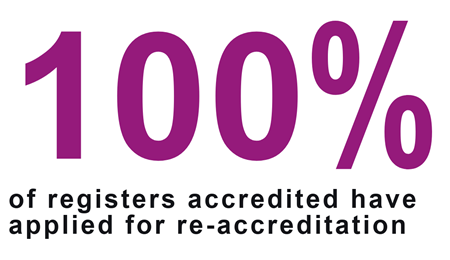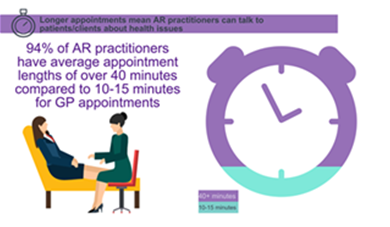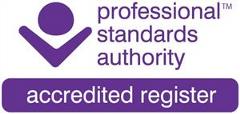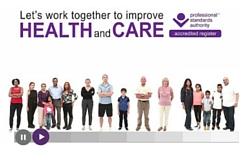Never heard of Accredited Registers before? In this blog, we’ll talk about the programme, why it exists and the gap it fills in public protection.

You’ll probably be aware of the regulation of professions governed by law, e.g. doctor, dentist, nurse. Their professional titles (and some practices) are legally protected, making it a crime to impersonate them. They are regulated by one of nine regulators – find out more here about what regulators do. Still not sure? Read our blog explaining more about what professional regulation in the UK is.
But not all health and care professions are treated in this way. While over 30 professions are regulated, there are many more which aren’t. In 2012, our remit was extended (in the new Health and Social Care Act) to include the establishment of an accreditation system for unregulated professions. This is now known as the Accredited Registers programme.
Organisations holding registers of unregulated professionals can apply to us for accreditation. You can find out more here about how the programme works. To date, 25 registers have been accredited, encompassing a total of around 85,000 healthcare practitioners.
Effectively, this gives the public two parallel systems of protection when they access healthcare services (through either public or private funding). But it’s also a little complicated to understand, so in this blog, we’ll explain the differences and connections between them.
Statutory and voluntary regulation, side by side
The critical difference between the two systems is that, unlike statutory regulation, there is no law that says anyone must register with organisations which hold an Accredited Register. That said, the programme offers the public a range of benefits. And, it’s undoubtedly in the public interest for the two systems of regulation to connect when appropriate.
For example, the regulator of doctors, the General Medical Council, has issued clear guidance that doctors can refer patients to practitioners on Accredited Registers. After all, the government itself recommends that people use only an Accredited Register when consulting a health practitioner who is not regulated by law.
It’s worth noting that the two systems don’t operate independently of one another. Some doctors, nurses, dentists, physiotherapists and pharmacists are also qualified to practice in areas such as complementary therapies or non-surgical cosmetic treatments. As such, they have chosen to apply for registration with an Accredited Register in addition to complying with the legal requirement to register with their statutory regulator. This demonstrates a personal commitment to the highest standards.
Practitioners on Accredited Registers play a vital support role for today’s health and care services. Many work in private practice; however, others are employed by the NHS and local authorities. With everyone in the NHS stretched so thinly, it’s more important now than ever to look for creative ways to plug the workforce gap. We’ve always said that Accredited Registers is one such solution.
Why would the public use someone on an Accredited Register?
Practitioners on the registers are in jobs that impact on the public’s health and wellbeing. They include nutritional therapists, play therapists, sports rehabilitators, counsellors and psychotherapists, foot health practitioners, acupuncturists, and a variety of complementary therapists, among others.
A member of the public may choose to see someone privately for care that the NHS doesn’t provide, or for which there is a long waiting list. Counselling is a prime example of this; it’s a treatment which many pay for, defeated by long waiting lists and limited free sessions.
Whatever the treatment, it’s important that the public knows this system of voluntary assurance exists. As mentioned, the government recommends the use of Accredited Registers, but raising public awareness is a drip, drip, drip process that requires dogged determination and investment from all involved.
Got a complaint? No problem
Another benefit of using someone on a register is the complaints process that we’ve built into the programme. It’s there for anyone who feels that the practitioner they’ve seen has not behaved appropriately. All registers must have a process for you to complain about their practitioners.
Remember that this doesn’t apply to practitioners who are not on one of our registers (and are not regulated by law).
Employers can also benefit by using health and care practitioners on Accredited Registers
The public is one of several groups for whom Accredited Registers are important. Anyone employing or commissioning a healthcare practitioner who is not regulated by law should be doing their due diligence and checking that person’s competence.
Employer checks only go so far, so the level of assurance offered by our accreditation can help mitigate potential risks.
Is accreditation easy to gain?

No. For an organisation to receive accreditation (and have permission to use the Accredited Registers Quality Mark), they must meet a set of 11
standards in areas including standards-setting, education and training, complaints handling and risk management. The process is exhaustive and can take many months to complete. This guarantees that accreditation is truly a mark of quality.
The two systems – statutory and voluntary – must work side-by-side for them to be truly effective. Anyone accessing healthcare should receive it from someone who is regulated by law or on an Accredited Register. This eliminates the possibility of poor care with no available recourse.
Related material
